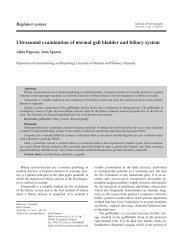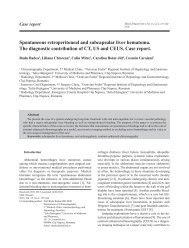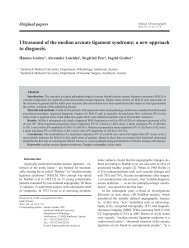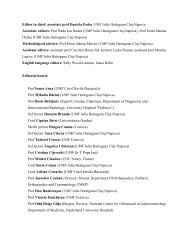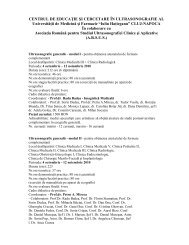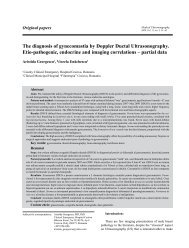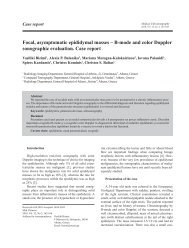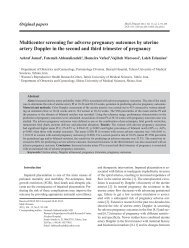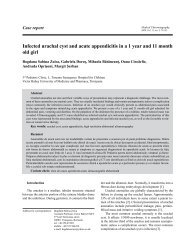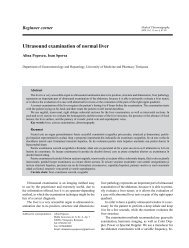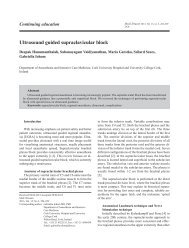Osgood-Schlatter disease - Medical Ultrasonography
Osgood-Schlatter disease - Medical Ultrasonography
Osgood-Schlatter disease - Medical Ultrasonography
Create successful ePaper yourself
Turn your PDF publications into a flip-book with our unique Google optimized e-Paper software.
Case report<br />
<strong>Medical</strong> <strong>Ultrasonography</strong><br />
2010, Vol. 12, no. 4, 336-339<br />
<strong>Osgood</strong>-<strong>Schlatter</strong> <strong>disease</strong> – ultrasonographic diagnostic<br />
Florentin Vreju, Paulina Ciurea, Anca Roşu<br />
Department of Rheumatology, University of Medicine and Pharmacy Craiova, Romania<br />
Abstract<br />
<strong>Osgood</strong>-<strong>Schlatter</strong> <strong>disease</strong> is a condition that is caused by traction of the muscle-tendon unit at tibial tuberosity, which affects<br />
adolescents who exercise. The predisposing factors include rapid growth and physical activity, particularly running and<br />
jumping. <strong>Osgood</strong>- <strong>Schlatter</strong> <strong>disease</strong> causes intermittent pain, which can be aggravated by running, cycling and climbing stairs.<br />
We present the case of a young boy, soccer player, which presented for pain at the level of the tibial tuberosity. <strong>Ultrasonography</strong><br />
showed changes at the distal part of the patellar tendon and at the tibial tuberosity, consistent with <strong>Osgood</strong>-<strong>Schlatter</strong> <strong>disease</strong>.<br />
Keywords: ultrasonography, <strong>Osgood</strong>-<strong>Schlatter</strong> <strong>disease</strong>, apophysitis, tibial tuberosity, patellar tendon.<br />
Rezumat<br />
Boala <strong>Osgood</strong>-<strong>Schlatter</strong> reprezintă o condiţie datorată tracţiunii exercitate de către unitatea muşchi- tendon la nivelul<br />
tuberozităţii tibiale, ce afectează sportivii adolescenţi. Factorii predispozanţi includ creşterea rapida şi activitatea fizică intensă,<br />
în special alergatul şi săritul. Boala <strong>Osgood</strong>-<strong>Schlatter</strong> se manifestă prin durere intermitentă, ce poate fi agravată de alergari,<br />
ciclism, urcat de scări. Prezentăm cazul unui adolescent, jucător de fotbal, ce s-a prezentat pentru durere la nivelul tuberozităţii<br />
tibiale. Ecografia musculoscheletală a evidenţiat modificări tipice pentru boala <strong>Osgood</strong>-<strong>Schlatter</strong>, la nivelul tendonului patelar<br />
distal şi la nivelul tuberozităţii tibiale.<br />
Cuvinte cheie: ecografie musculoscheletală, boala <strong>Osgood</strong>-<strong>Schlatter</strong>, apofizită, tuberozitate tibială, tendon patelar.<br />
Introduction<br />
<strong>Osgood</strong>-<strong>Schlatter</strong> <strong>disease</strong>, named for the doctors that<br />
first described it [1,2], in 1903, is a traction apophysitis<br />
of the tibial tuberosity, due to repetitive strain from<br />
the quadriceps muscle, and chronic avulsion of the tibia,<br />
which may occur in the preossification phase or the ossified<br />
phase of the secondary ossification center. The maturation<br />
of tibial apophysis has four stages, as Ehrenborg<br />
and Engfeldt described it: cartilaginous stage between<br />
0– 11 years, apophyseal stage between 11–14 years, epiphyseal<br />
stage, when the tibial joins with tibial apophysis<br />
Received Accepted<br />
Med Ultrason<br />
2010, Vol. 12, No 4, 336-339<br />
Address for correspondence: Florentin Vreju<br />
Rheumatology Department, University of<br />
Medicine and Pharmacy Craiova<br />
Petru Rares 2-4, Craiova, Romania<br />
Email: florin_vreju@yahoo.com<br />
between 14–18 years and the bony stage, when the epiphysis<br />
is fully fused, after 18 years. It seems that most<br />
of the cases of <strong>Osgood</strong>-<strong>Schlatter</strong> <strong>disease</strong> occur in the<br />
apophyseal stage, the common age of presentation being<br />
between 12 and 15 years for boys and between 8 and 12<br />
years for girls [3].<br />
The symptoms range from aching and soreness, to<br />
swelling, severe pain and limping. The onset is gradual,<br />
with mild, intermittent pain, but in acute phases, the pain<br />
may become severe and continuous. Pain exacerbates<br />
after physical activity involving running or jumping or<br />
after kneeling. Physical examination usually finds tenderness<br />
directly over the area of the tibial tuberosity and<br />
local swelling. The pain can be reproduced with extension<br />
of the knee against resistance.<br />
The diagnosis is mostly clinical, but imagistic methods<br />
are often used to confirm it. Abnormality of the secondary<br />
ossification center of the tibial tubercle is evident<br />
on conventional radiography and ranges from irregularity<br />
of the apophysis with separation from the tibial tu-
erosity to fragmentation in the later stages [4]. The<br />
same changes have been identified as characteristic for<br />
<strong>Osgood</strong>-<strong>Schlatter</strong> <strong>disease</strong> on ultrasound [3,5,6] and magnetic<br />
resonance images (MRI) [7].<br />
The treatment is usually conservative, with medication<br />
and ice to relieve pain and stretching and strengthening<br />
exercises preceded by local warm packs. Surgery is<br />
rarely recommended in the growing patient, if conservative<br />
treatment has failed.<br />
Case presentation<br />
A 14-year-old boy was referred to our department for<br />
clinical examination and sonographic evaluation. The<br />
patient, a soccer player for 8 years, presented with pain<br />
and local tenderness at the level of the tibial tuberosity,<br />
accompanied by asymmetric, local swelling. The symptoms,<br />
more intense in the right knee, were exacerbated<br />
by training, especially straightening the leg against force<br />
(stair climbing, jumping, deep knee bends, or weightlifting)<br />
or following an extended period of vigorous exercise,<br />
and had led to limitation of the physical activity.<br />
We found the same symptoms in the left knee, but with a<br />
lower intensity. Previous biologic evaluation was uncharacteristic,<br />
except that the patient was HLA-B27 positive.<br />
Musculoskeletal ultrasound, in gray scale and Doppler,<br />
was performed with a high-frequency linear array<br />
transducer, on a Siemens ACUSON X300 machine. The<br />
proximal head of the patellar tendon was normal in both<br />
knees, with a normal anterior surface of patella as a thin<br />
echogenic line. Longitudinal sonography of the distal<br />
<strong>Medical</strong> <strong>Ultrasonography</strong> 2010; 12(4): 336-339 337<br />
head of the right patellar tendon showed swelling of the<br />
unossified cartilage and overlying soft tissues, with reduced<br />
internal echogenicity and thickening of the tendon<br />
(fig 1). Underneath, we were able to see fragmentation<br />
of the bone and irregularity of the ossification<br />
center (fig 2).<br />
The anteroposterior thickness of the patellar tendon<br />
at the insertion on the tibial tuberosity was 5.7 mm on<br />
the right knee and 3.8 mm on the left one, with the increase<br />
in size due to a focal area of low echogenicity in<br />
posterior portion of tendon. Over the tibial tuberosity, the<br />
right patellar tendon decreases its size, however remaining<br />
thicker than the left one. Power Doppler ultrasonography<br />
showed a low signal along the distal right patellar<br />
tendon and posterior to the tendon, at the level of a bone<br />
irregularity.<br />
These findings were consistent with the diagnosis of<br />
the <strong>Osgood</strong>-<strong>Schlatter</strong> <strong>disease</strong> and the patient was advised<br />
to stop the activities which had caused pain, to use topical<br />
NSAID and ice packs and was referred to the kinetotherapy<br />
department, to learn stretching and strengthening<br />
exercises.<br />
Discussion<br />
<strong>Osgood</strong>-<strong>Schlatter</strong> <strong>disease</strong> is quite frequent in adolescents,<br />
the occurrence being reported as greater in boys<br />
than girls [8,9] and frequently bilaterally (20–30%). Together<br />
with the Sinding-Larsen-Johansson <strong>disease</strong>, OSD<br />
is responsible for disability of the knee joint in adolescents<br />
practicing sports.<br />
Fig 1. Longitudinal US scan of the distal insertion of the patellar<br />
tendon, with a small bulging of the tibial tuberosity. Cartilage<br />
thickness (double arrows) between the ossification center<br />
and the patellar tendon attachment (left), Normal tibial tuberosity,<br />
contralateral side (right) E, epiphysis; M, metaphysis.<br />
Fig 2. Longitudinal US image of the tibial tuberosity, with the<br />
cartilage thickness (double arrows) between the ossification<br />
center and the patellar ligament attachment and delamination<br />
of the ossification center.
338 Florentin Vreju et al <strong>Osgood</strong>-<strong>Schlatter</strong> <strong>disease</strong> – ultrasonographic diagnostic<br />
Histological studies performed on the tibial tuberosity<br />
growth plate have revealed three zones that gradually<br />
coalesce. The proximal zone, formed of short cell columns,<br />
is analogous to the upper tibial growth plate. The<br />
middle zone consists mostly of fibrocartilage that alternates<br />
with layers of hyaline cartilage. The distal zone is<br />
made mainly of fibrous tissue.<br />
During the maturation of the tibial tuberosity through<br />
the apophyseal to epiphyseal stages, the most important<br />
change is distal migration of the short cell columns replacing<br />
fibrocartilage. Thus, OSD might be caused by the<br />
new developing ossification center’s inability to strive to<br />
the quadriceps forces, resulting in avulsion of the center<br />
and later new bone formation[10]. OSD occurs in the ossification<br />
centers, due to traction and not compression<br />
stress at the level of the patella or the tibial tuberosity,<br />
and for this reason, it has been called “non-articular osteochondrosis”<br />
[5].<br />
The prognosis of the <strong>Osgood</strong>-<strong>Schlatter</strong> <strong>disease</strong> is<br />
good, with a self-limiting course and complete recovery<br />
with the closure of the tibial growth plate. About 80% of<br />
patients respond well to conservative treatment<br />
In more than 10% of the cases, complications can<br />
occur, such as pseudarthrosis or migration of a separate<br />
ossicle in the patellar tendon, with premature closure of<br />
the anterior tibial epiphysis resulting in genu recurvatum<br />
(hyper-extension). This may further result in a highriding<br />
patella (patella alta), with increasing joint reactive<br />
forces at the patellofemoral articulation, and potentially<br />
leading to early osteoarthritis of that joint. Another complication<br />
is persistence of pain into late adolescence or<br />
adulthood usually due to the bony prominence at the<br />
tibial tubercle, which results from the small ossicle and<br />
forms from the fragmentation of the apophysis. This ossicle<br />
may impinge on the patellar tendon, causing pain and<br />
limiting activity. More than that, there are studies [11]<br />
which sustain an association of <strong>Osgood</strong> <strong>Schlatter</strong>’s <strong>disease</strong><br />
and patellar instability. Patellar tendon avulsions are<br />
possible sequellae to <strong>Osgood</strong>-<strong>Schlatter</strong> <strong>disease</strong>. Thereby,<br />
an early diagnosis is important, to stop any activity that<br />
requires knee bending and jumping.<br />
Unlike, in other cases, it is important to not overtreatthese<br />
patients. Glucocorticoid injections, which might be<br />
necessary to treat other <strong>disease</strong>s, have a low beneficial<br />
effect in <strong>Osgood</strong> <strong>Schlatter</strong> <strong>disease</strong> and might lead to subcutaneous<br />
atrophy, striae formation in the skin overlying<br />
the tibial tubercle and in rare cases, to a more severe<br />
complication – tendon rupture.<br />
The diagnosis of OSD is clinical, but plain radiographs<br />
of the knee are recommended in all unilateral cases to rule<br />
out other conditions such as tibial apophyseal fracture, infection,<br />
or tumor. Conventional radiographs of the knee<br />
show, in the lateral view, an irregularity of the apophysis,<br />
with separation from the tibial tuberosity, in early stages<br />
and fragmentation, in the later stages [4]. However, radiography<br />
cannot give complete information about the involvement<br />
of the non-osseous tissues, which may provide<br />
a diagnostic hallmark in the early stages. In these cases,<br />
soft tissue swelling, especially of the infrapatellar fat pads<br />
may be the only evidence of this <strong>disease</strong>. More than that,<br />
considering that the <strong>disease</strong> occurs in children and preteenagers,<br />
Röntgen exposure should be avoided, MRI<br />
and ultrasound being the choice, with the emphasis on<br />
thelatter. This should be the first-choice examination in<br />
both the diagnosis and the follow-up of <strong>Osgood</strong>-<strong>Schlatter</strong><br />
<strong>disease</strong> due to its availability and lower costs.<br />
Magnetic resonance imaging can identify five stages<br />
of the <strong>disease</strong>: normal, early, progressive, terminal and<br />
healing. The normal stage reveals no changes on the MRI<br />
scan, although the patient is symptomatic. The MRI scan<br />
shows signs of inflammation in the area of the secondary<br />
ossification centre. The progressive stage reveals partial<br />
cartilage avulsion at the level of the secondary ossification<br />
centre. The terminal stage shows separated ossicles<br />
and the healing stage can be defined as osseous healing<br />
without separated ossicles at the level of the tibial tuberosity<br />
[12].<br />
<strong>Ultrasonography</strong> of the patellar tendon enthesis can<br />
differentiate three stages of the <strong>disease</strong>, based on the following<br />
criteria: presence or absence of a large anechoic<br />
region, presence or absence of ossicles and irregularity of<br />
the apophyseal surface. Stage 1 (cartilage attachment) is<br />
characterized by a large anechoic region (apophyseal cartilage),<br />
with or without ossicles. Stage 2 (insertional cartilage)<br />
shows the attachment of the collagen fibers onto<br />
the bone surface, with a thin anechoic layer of cartilage.<br />
Stage 3 represents the mature attachment of the collagen<br />
fibers onto the bone surface [13].<br />
This case has confirmed the complexity of the relationship<br />
between pain and imaging and revealed the<br />
importance that sonography has in the assessment of the<br />
patellar tendon changes and of the adjacent anatomic<br />
structures. Furthermore, musculoskeletal ultrasonography<br />
was able to differentiate <strong>Osgood</strong>-<strong>Schlatter</strong> <strong>disease</strong><br />
from a possible HLA-B27 related enthesopathy, allowing<br />
us to make the correct diagnosis and choose the conservative<br />
treatment.<br />
References<br />
1. <strong>Osgood</strong> RB. Lesions of the tibial tubercle occurring during<br />
adoloscence. Boston Med Surg J 1903; 148: 114–117.<br />
2. <strong>Schlatter</strong> C. Verletzungen des schnabelformigen Fortsatzes<br />
der oberen Tibiaepiphyse. Beitr Klin Chir 1903; 38: 874–887.
3. Blankstein A, Cohen I, Heim M, et al. <strong>Ultrasonography</strong> as<br />
a diagnostic modality in <strong>Osgood</strong>-<strong>Schlatter</strong> <strong>disease</strong>. A clinical<br />
study and review of the literature. Arch Orthop Trauma<br />
Surg 2001; 121: 536–539.<br />
4. Gholve PA, Scher DM, Khakharia S, Widmann RF, Green<br />
DW. <strong>Osgood</strong> <strong>Schlatter</strong> syndrome. Curr Opin Pediatr 2007;<br />
19: 44–50.<br />
5. De Flaviis L, Nessi R, Scaglione P, Balconi G, Albisetti W,<br />
Derchi LE. Ultrasonic diagnosis of <strong>Osgood</strong>- <strong>Schlatter</strong> and<br />
Sinding-Larsen- Johansson <strong>disease</strong>s of the knee. Skeletal<br />
Radiol 1989: 18: 193–197.<br />
6. Lanning P, Heikkinen E. Ultrasonic features of the<br />
<strong>Osgood</strong>‐<strong>Schlatter</strong> lesion. J Pediatr Orthop 1991; 11: 538–<br />
540.<br />
7. Demirag B, Ozturk C, Yazici Z, Sarisozen B. The pathophysiology<br />
of <strong>Osgood</strong>- <strong>Schlatter</strong> <strong>disease</strong>: a magnetic<br />
resonance investigation. J Pediatr Orthop B 2004; 13:<br />
379–382.<br />
<strong>Medical</strong> <strong>Ultrasonography</strong> 2010; 12(4): 336-339<br />
8. Orava S, Malinen L, Karpakka J, et al. Results of surgical<br />
treatment of unresolved <strong>Osgood</strong>–<strong>Schlatter</strong> lesion. Ann Chir<br />
Gynaecol 2000; 89: 298–302.<br />
9. Ehrenborg G. The <strong>Osgood</strong>–<strong>Schlatter</strong> lesion: a clinical study<br />
of 170 cases. Acta Chir Scand 1962; 124: 89–105.<br />
10. Ogden JA, Southwick WO. <strong>Osgood</strong>–<strong>Schlatter</strong>’s <strong>disease</strong><br />
and tibial tuberosity development. Clin Orthop Relat Res<br />
1976; 116: 180–189.<br />
11. JC Léonard, JF Albecq, H Leclet, C Morin. Complications<br />
of <strong>Osgood</strong>-<strong>Schlatter</strong>’s <strong>disease</strong>: a certainly deceitful <strong>disease</strong>.<br />
Science and Sports 1995; 10: 95-101.<br />
12. Hirano A, Fukubayashi T, Ishii T, Ochiai N. Magnetic resonance<br />
imaging of <strong>Osgood</strong>–<strong>Schlatter</strong> <strong>disease</strong>: the course of<br />
the <strong>disease</strong>. Skeletal Radiol 2002; 31: 334–342.<br />
13. Ducher G, Cook J, Spurrier D, et al. Ultrasound imaging of<br />
the patellar tendon attachment to the tibia during puberty:<br />
a 12-month follow-up in tennis players. Scand J Med Sci<br />
Sports 2010; 20: e35–e40.<br />
339



